1994 BUICK REGAL engine coolant
[x] Cancel search: engine coolantPage 221 of 308

Engine Coolant Heater (Engine Block
Heater)
An engine coolant heater can be a big help if you have
to park outside in very cold weather, 0°F (- 18 “C) or
colder. If your vehicle has this option, see “Engine
Coolant Heater”
in the Index.
What to Do with Used Oil
Did you know that used engine oil contains certain
elements that may be unhealthy for your skin and could
even cause cancer? Don’t let used oil stay on your skin
for very long. Clean your skin and nails
with soap and
water,
or a good hand cleaner. Wash or properly throw
away clothing or rags containing used engine
oil. (See
the manufacturer’s warnings about the use and disposal
of
oil products.)
Used oil can be a real threat to the environment. If you
change your own
oil, be sure to drain all free-flowing
oil from the filter before disposal. Don’t ever dispose of
oil by putting it in the trash, pouring it on the ground,
into sewers, or into streams or bodies of water. Instead,
recycle
it by taking it to a place that collects used oil. If
you have a problem properly disposing of your used oil,
ask your dealer, a service station or a local recycling
center for help.
Air Cleaner
The air cleaner is in the right front area of the engine
compartment.
Refer to the Maintenance Schedule to determine when
to replace the air filter.
See “Scheduled Maintenance Services”
in the Index.
219
ProCarManuals.com
Page 225 of 308
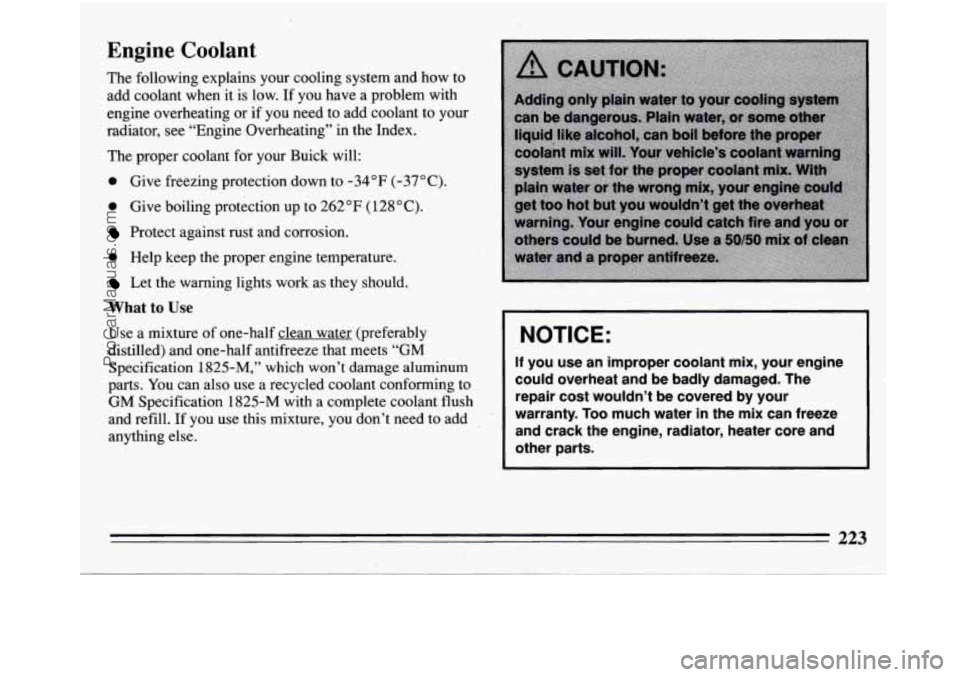
Engine Coolant
The following explains your cooling system and how to
add coolant when it is low. If you have a problem with
engine overheating or if you need to add coolant to your
radiator, see “Engine Overheating” in the Index.
The proper coolant for your Buick will:
0 Give freezing protection down to -34°F (-37°C).
0 Give boiling protection up to 262°F (128°C).
Protect against rust and corrosion.
0 Help keep the proper engine temperature.
Let the warning lights work as they should.
What to Use
Use a mixture of one-half clean water (preferably
distilled) and one-half antifreeze that meets “GM Specification
1825-M,” which won’t damage aluminum
parts. You can also use a recycled coolant conforming to
GM Specification 1825-M with a complete coolant flush
and refill.
If you use this mixture, you don’t need to add
anything else.
NOTICE:
If you use an improper coolant mix, your engine
could overheat and be badly damaged. The repair cost wouldn’t be covered by your
warranty. Too much water in the mix can freeze
‘and crack the engine, radiator, heater core and other parts.
223
ProCarManuals.com
Page 226 of 308
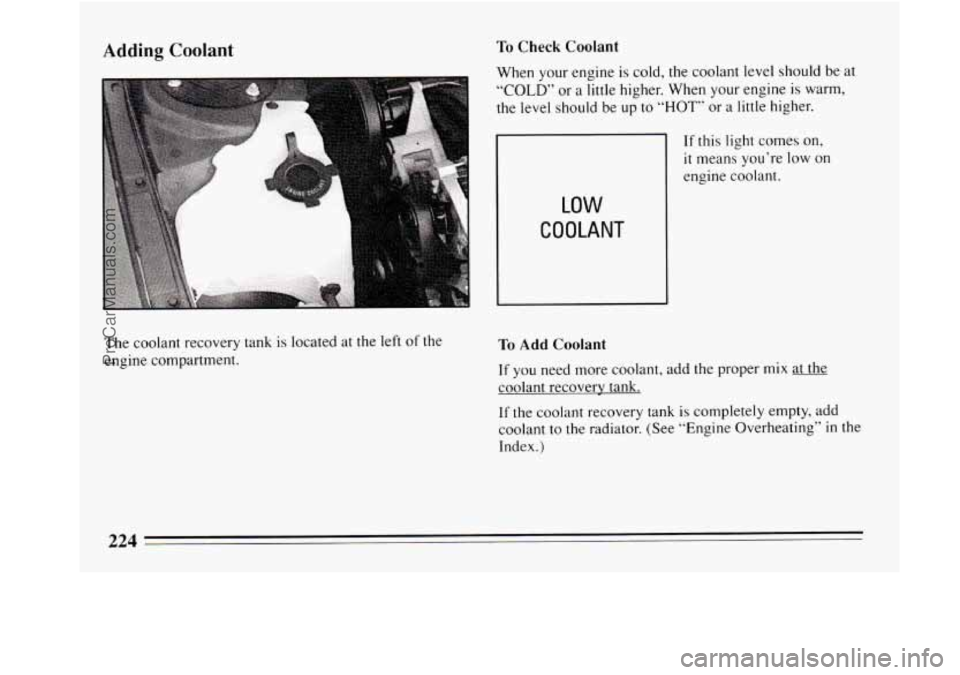
Adding Coolant
The coolant recovery tank is located at the left of the
engine compartment.
To Check Coolant
When your engine is cold, the coolant level should be at
“COLD” or a little higher. When your engine is warm,
the level should be up to
“HOT” or a little higher.
LOW
COOLANT
If this light comes on,
it means you’re low on
engine coolant.
To Add Coolant
If you need more coolant, add the proper mix at the
coolant recovery tank.
If the coolant recovery tank is completely empty, add
coolant to the radiator. (See “Engine Overheating” in the
Index.)
224
ProCarManuals.com
Page 227 of 308

A CAUTION:
Turning the radiator pressure cap when the
engine
and radiator are hot can allow steam and
scalding liquids
to blow out and burn you badly.
With the coolant recovery tank, you will almost
never have
to add coolant at the radiator. Never
turn the radiator pressure cap -- even a little --
when the engine and radiator are hot.
Add coolant mix at the recovery tank, but be careful not
to spill it.
A CAUTION:
You can be burned if you spifl coolant on hot
engine parts. Coolant contains ethylene glycol,
and
it will burn if the engine parts are hot
enough. Don’t spill coolant on a hot engine.
Radiator Pressure Cap
NOTICE:
Your radiator cap is a 15 psi (1 05 kPa)
pressure-type cap and must be tightly installed
to prevent coolant
loss and possible engine
damage from overheating. Be sure the arrows on
the cap line up with the overflow tube on the
radiator filler neck.
When you replace your radiator pressure cap, an AC@
cap
is recommended.
Thermostat
Engine coolant temperature is controlled by a thermostat
in the engine coolant system. The thermostat stops the
flow of coolant through the radiator until the coolant
reaches a preset temperature.
When
you replace your thermostat, an AC@ thermostat
is recommended.
225
ProCarManuals.com
Page 274 of 308
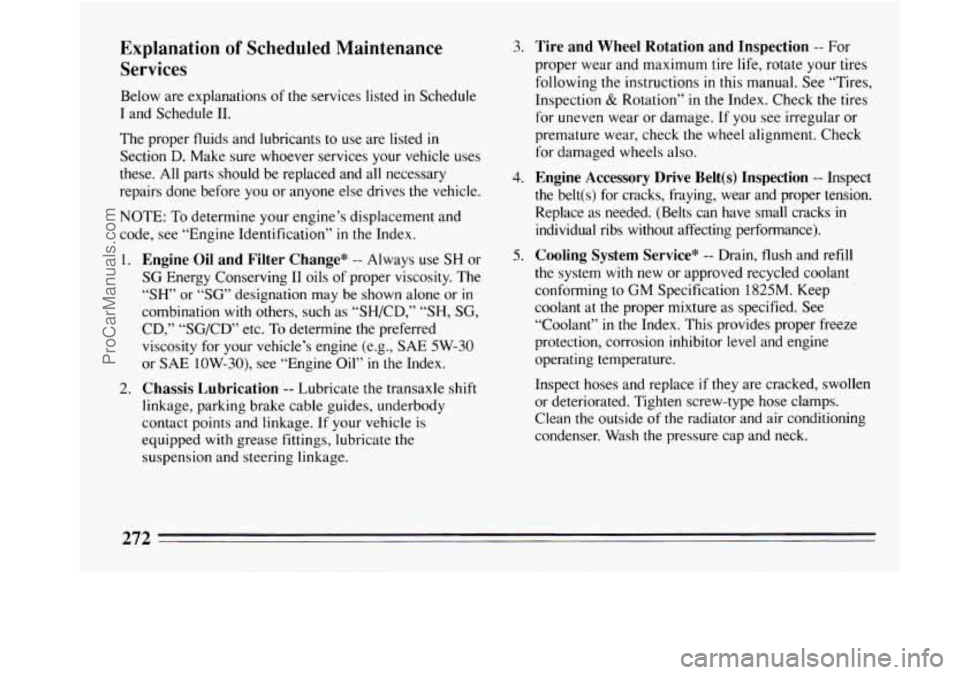
Explanation of Scheduled Maintenance
Services
Below are explanations of the services listed in Schedule
I and Schedule 11.
The proper fluids and lubricants to use are listed
in
Section D. Make sure whoever services your vehicle uses
these. All
parts should be replaced and all necessary
repairs done before you or anyone else drives the vehicle.
NOTE: To determine your engine’s displacement and
code, see “Engine Identification”
in the Index.
1.
Engine Oil and Filter Change* -- Always use SH or
SG Energy Conserving I1 oils of proper viscosity. The
“SH” or “SG” designation may be shown alone or in
combination with others, such as “SH/CD,” “SH, SG,
CD,” “SG/CD” etc.
To determine the preferred
viscosity for your vehicle’s engine (e.g., SAE 5W-30-
or SAE 10W-30), see “Engine Oil” in the Index.
2. Chassis Lubrication -- Lubricate the transaxle shift
linkage, parking brake cable guides, underbody
contact points and linkage. If your vehicle is
equipped with grease fittings, lubricate the
suspension and steering linkage. 3.
4.
5.
Tire
and Wheel Rotation and Inspection -- For
proper wear and maximum tire life, rotate your tires
following the instructions
in this manual. See “Tires,
Inspection
& Rotation” in the Index. Check the tires
for uneven wear or damage. If you see irregular or
premature wear, check the wheel alignment. Check
for damaged wheels also.
Engine Accessory Drive Belt(s) Inspection -- Inspect
the belt(s) for cracks, fraying, wear and proper tension.
Replace as needed. (Belts can have small cracks
in
individual ribs without affecting performance).
Cooling System Service* -- Drain, flush and refill
the system
with new or approved recycled coolant
conforming to GM Specification
1825M. Keep
coolant at the proper mixture as specified. See
“Coolant”
in the Index. This provides proper freeze
protection, corrosion inhibitor level and engine
operating temperature.
Inspect hoses and replace if they are cracked, swollen
or deteriorated. Tighten screw-type hose clamps.
Clean the outside of the radiator and air conditioning
condenser. Wash the pressure cap and neck.
272
ProCarManuals.com
Page 276 of 308
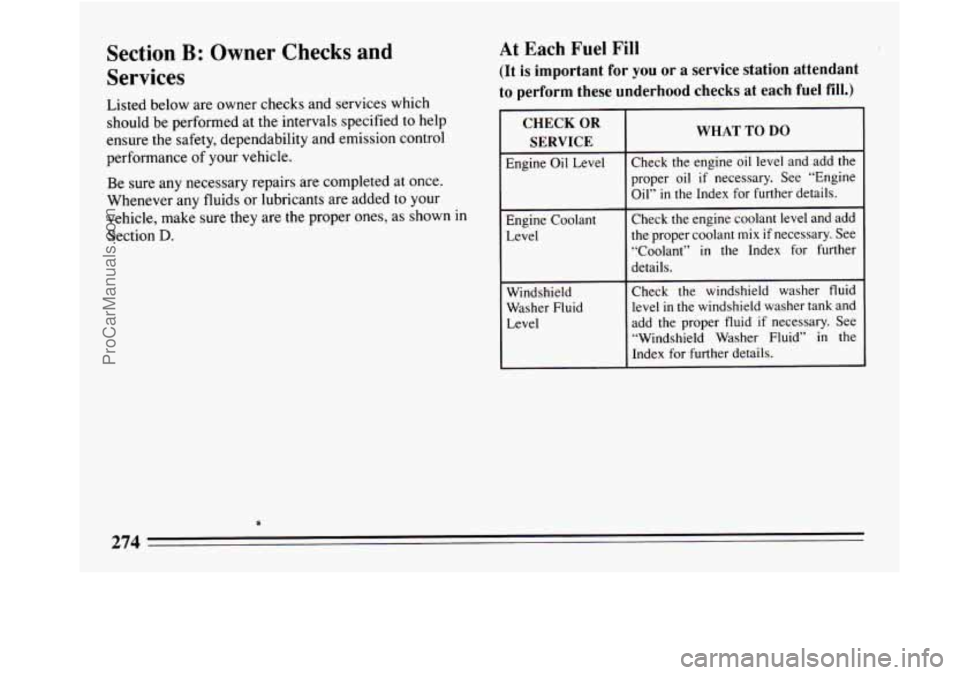
Section B: Owner Checks and
Services
Listed below are owner checks and services which
should be performed at the intervals specified to help
ensure the safety, dependability and emission control
performance
of your vehicle.
Be sure any necessary repairs are completed at once.
Whenever any fluids or lubricants are added to your
vehicle, make sure they are
the proper ones, as shown in
Section
D.
At Each Fuel Fill
(It is important for you or a service station attendant
to perform these underhood checks at each fuel fill.)
CHECK OR
I SERVICE
Engine Oil Level
Level
Level
WHAT TO DO
Check the engine oil level and add the
proper oil
if necessary. See “Engine
Oil” in the Index for further details.
Check the engine coolant level and add
the proper coolant
mix if necessary. See
“Coolant”
in the Index for further
details.
Check the windshield washer fluid
level
in the windshield washer tank and
add the proper fluid
if necessary. See
“Windshield Washer Fluid” in the
Index for further details.
0
274
ProCarManuals.com
Page 281 of 308
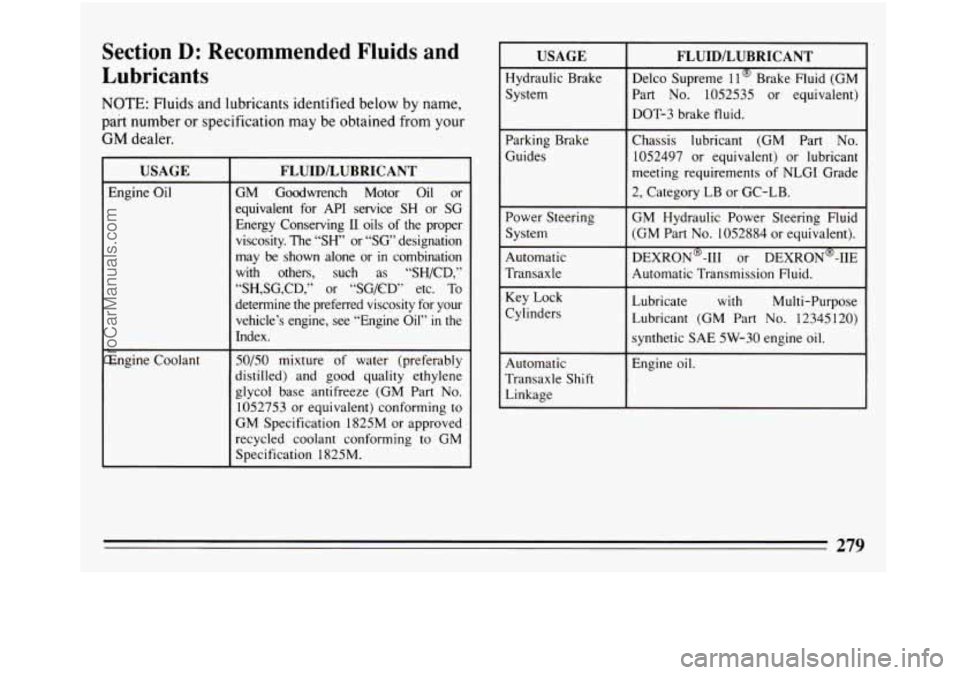
Section D: Recommended Fluids and
Lubricants
NOTE: Fluids and lubricants identified below by name,
pai-t number or specification may be obtained from your
GM dealer.
USAGE
Engine Oil
-
-
-
Engine Coolant
FLUIDlLUBRICANT
GM Goodwrench Motor Oil or
equivalent for
API service SH or SG
Energy Conserving
I1 oils of the proper
viscosity. The
“SH’ or “SG’ designation
may be shown alone or in combination with others, such as “SH/CD,”
“SH,SG,CD,” or “SG/CD” etc. To
determine the preferred viscosity for your vehicle’s engine, see “Engine Oil”
in the
Index.
50/50 mixture of water (preferably
distilled) and good quality ethylene
glycol base antifreeze (GM Part
No.
1052753 or equivalent) conforming to
GM Specification 1825M
or approved
recycled coolant conforming to GM
Specification
1825M.
USAGE
Hydraulic Brake
System
Parking Brake
Guides
Power Steering
System
Automatic
Transaxle
Key Lock
Cylinders
Automatic
Transaxle Shift
Linkage
FLUIDlLUBRICANT
Delco Supreme ll@ Brake Fluid (GM
Part No. 1052535 or equivalent)
DOT-3 brake fluid.
Chassis lubricant (GM Part No.
1052497 or equivalent) or lubricant
meeting requirements of NLGI Grade
2, Category LB or GC-LB.
GM Hydraulic Power Steering Fluid
(GM Part
No. 1052884 or equivalent).
DEXRON@-111
or DEXRON@-IIE
Automatic Transmission Fluid.
Lubricate
with Multi-Purpose
Lubricant (GM Part
No. 12345120)
synthetic SAE 5W-30 engine oil.
Engine oil.
279
ProCarManuals.com
Page 295 of 308
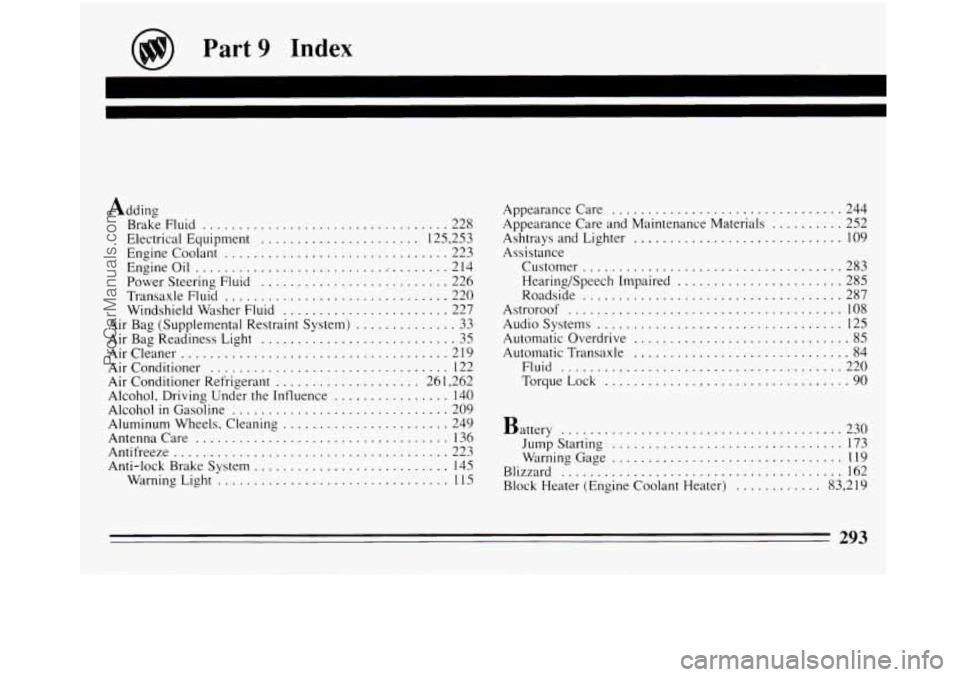
Part 9 Index
Adding Brake Fluid
.................................. 228
Electrical Equipment
...................... 125. 253
Engine Coolant
............................... 223
Engine Oil
.................................... 2 14
Power Steering Fluid
.......................... 226
Transaxle Fluid
............................... 220
Windshield Washer Fluid
....................... 227
Air Bag (Supplemental Restraint System)
.............. 33
Air Bag Readiness Light
........................... 35
Aircleaner
..................................... 219
Air Conditioner
................................. 122
Air Conditioner Refrigerant .................... 26 1. 262
Alcohol. Driving Under the Influence
................ 140
Alcohol
in Gasoline .............................. 209
Aluminum Wheels. Cleaning
....................... 249
Antenna Care
................................... 136
Antifreeze
...................................... 223
Anti-lock Brake System
........................... 145
Warning Light
................................ 115
Appearance Care ................................ 244
Ashtrays and Lighter
............................. 109
Assistance Customer
.................................... 283
Hearing/Speech Impaired
....................... 285
Roadside
.................................... 287
Astroroof
...................................... 108
Audio Systems
.................................. 125
Automatic Overdrive
.............................. 85
Automatic Transaxle .............................. 84
Fluid ....................................... 220
TorqueLock .................................. 90
Appearance
Care and Maintenance Materials
.......... 252
Battery
....................................... 230
Jump Starting
................................ 173
WarningGage
................................ 119
Blizzard
....................................... 162
Block Heater (Engine Coolant Heater)
............ 83. 219
293
ProCarManuals.com